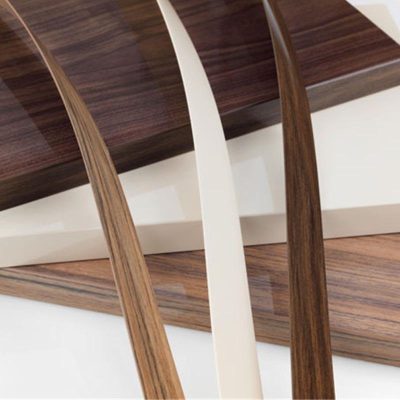Edge banding is a manufacturing process in which a thin strip of material is applied to the raw edges of furniture panels, such as those made from MDF (medium-density fiberboard), particleboard, plywood, or other composite materials. This process is used to cover the exposed edges of these panels, giving furniture a cleaner, more finished look while also improving its durability.
In this article, we’ll explain the basic concept of edge banding, the materials commonly used, and how the process works in the production of furniture.
Why Is Edge Banding Important?
Raw edges on materials like MDF or particleboard are often rough and unattractive. Additionally, these exposed edges are more vulnerable to damage, moisture, and wear. Edge banding solves these issues by providing a protective layer and a smooth, polished finish that improves both the aesthetics and longevity of the furniture.
Common Materials Used for Edge Banding
The material selected for edge banding depends on the desired appearance, functionality, and budget. Here are the most common types of edge banding materials:
- PVC (Polyvinyl Chloride) Edge Banding
PVC is one of the most widely used edge banding materials due to its durability, affordability, and versatility. It comes in a variety of colors, textures, and finishes, making it ideal for a wide range of furniture styles. - Wood Veneer
Wood veneer edge banding provides a natural, authentic wood look. It’s typically used on furniture that is meant to mimic solid wood or for more high-end designs. - ABS (Acrylonitrile Butadiene Styrene) Edge Banding
ABS edge banding is highly durable, flexible, and resistant to impact and wear. It’s often used for more robust furniture pieces and is available in a range of colors and finishes. - Melamine Edge Banding
Melamine edge banding is affordable and available in a variety of colors and textures. It’s commonly used in modern furniture designs and laminate furniture. - Aluminum and Metal Edge Banding
Metal edge banding offers a sleek, modern look and is known for its strength and durability. It’s typically used in commercial furniture or in designs where an industrial aesthetic is desired. - Leather Edge Banding
Leather edge banding is a premium choice used in luxury furniture designs. It provides a unique texture and appearance that stands out in high-end furniture pieces.
How Is Edge Banding Applied?
The process of applying edge banding involves several key steps:
- Preparation of the Panel
The panel, typically made from MDF, particleboard, or plywood, is cut to size. The raw edges are then sanded and prepared to ensure a smooth surface for the adhesive. - Applying Adhesive
A strong adhesive is applied to the raw edges of the panel. This can be done manually or using an edge banding machine, depending on the scale of production. - Attaching the Edge Banding
The edge banding strip is placed on the adhesive-covered edge. In most cases, heat or pressure is applied to ensure a strong bond. For machine applications, the adhesive often comes in the form of a hot-melt glue that adheres quickly. - Trimming and Finishing
After the edge banding is applied, any excess material is trimmed off. The edges are then smoothed to create a seamless, professional finish. This may involve using a router or a specialized trimmer to ensure a clean and precise result.
Conclusion
Edge banding is a simple yet essential process that greatly enhances the appearance, durability, and quality of furniture. By covering the raw edges of panels, it provides a smooth, finished look while also protecting the material from moisture and wear. Whether using PVC, wood veneer, ABS, or other materials, edge banding is a versatile technique that contributes to the overall aesthetic and performance of the furniture.
If you’re a furniture manufacturer, choosing the right edge banding material and applying it correctly will result in a polished and durable product that stands the test of time.

